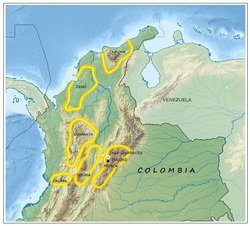Cultures of Pre-Columbian Gold
|
Calima
The upper and middle region of the river Calima and the fertile plains of the river Cauca were occupied by hunter-gatherer societies evolving towards agriculture. Gold artefacts ranged from diadems, pendants, nose ornaments and breast plates. In the later period, the goldwork was concentrated on the production of ornaments for the face. Tolima The warm middle valley of the river Magdalena, which today includes the department of Tolima, was inhabited by groups of fishermen, hunters and gatherers. The metalworking art of Tolima was intended to capture transformation and the taking on of the attributes of animals. Breastplates and pendants in different variations showing a man transfigured into a bat, a bird or a jaguar. |
Quimbaya
The area of the mountainous Middle Cauca hosted many societies of farmers, hunters and gold miners. During the late Quimbaya period, which lasted up to the Spanish conquest, many changes took place in society, economy, aesthetics and metallurgy. The production of various objects for the face began to predominate. They were now producing flat hammered embossed gold breast plates with mythical motifs and rounded bodily contours. The schematised human figures were zoomorphic features allude to schemanic transformation. The Quimbaya were one of the strongest communities in fighting against the Spanish invasion of their territories.
Zenú
The warm flood plaines of the Colombian Caribbean were inhabited by groups of gatherers, hunters and potters. To enable them to control the floods and make use of the area for dwellings, fishing and the growing of crops societies constructed an extraordinary network of hydraulic drainage canals. Textiles fulfilled a fundamental and symbolic role. The structure of fabric seems to have been associated with the canal network and the existence of life, resulting in filigree earrings depicting a fabric surrounded by living beings and water. At the height of their civilization they buried their leaders in tombs accompanied by impressive gold breasplates.
Tairona
The Tairona lived in the coastal bays running along the foot of the Sierra Nevada. they produced realistic and fantastic human and animal inspired ornaments. In the Tairona period, the society was governed by an elite of shamans who exercised power over society, nature and the cosmos. Breastplates were produced with the form of a man with a bat mask and a large ornament of feathers shaped like spirals and birds. The bat was associated with darkness and the nocturnal world.
Spiritual leaders believed that by wearing such ornaments during rituals, their spirits could take on the strength, agility in flight and night vision of the bats themselves.
Muisca
The inter-Andean highlands and valleys of the Eastern Andes were occupied by hunters and gatherers who progressively adopted agriculture and pottery. Three styles of goldwork can be distinguished in the area. In the centre, the figures of birds and human representations with coffee bean shaped eyes and mouths. In the west on the mountain slopes, elaborate anthromorphic motifs in its decorations. And finally, simple hammered style which refers to simple objects for use on the face and body in which circular and half moon forms are prevalent. Calima goldsmiths were masters of the hammering technique . Some of the most elaborate objects they produced are decorated with fine repousse images and patterns.
The area of the mountainous Middle Cauca hosted many societies of farmers, hunters and gold miners. During the late Quimbaya period, which lasted up to the Spanish conquest, many changes took place in society, economy, aesthetics and metallurgy. The production of various objects for the face began to predominate. They were now producing flat hammered embossed gold breast plates with mythical motifs and rounded bodily contours. The schematised human figures were zoomorphic features allude to schemanic transformation. The Quimbaya were one of the strongest communities in fighting against the Spanish invasion of their territories.
Zenú
The warm flood plaines of the Colombian Caribbean were inhabited by groups of gatherers, hunters and potters. To enable them to control the floods and make use of the area for dwellings, fishing and the growing of crops societies constructed an extraordinary network of hydraulic drainage canals. Textiles fulfilled a fundamental and symbolic role. The structure of fabric seems to have been associated with the canal network and the existence of life, resulting in filigree earrings depicting a fabric surrounded by living beings and water. At the height of their civilization they buried their leaders in tombs accompanied by impressive gold breasplates.
Tairona
The Tairona lived in the coastal bays running along the foot of the Sierra Nevada. they produced realistic and fantastic human and animal inspired ornaments. In the Tairona period, the society was governed by an elite of shamans who exercised power over society, nature and the cosmos. Breastplates were produced with the form of a man with a bat mask and a large ornament of feathers shaped like spirals and birds. The bat was associated with darkness and the nocturnal world.
Spiritual leaders believed that by wearing such ornaments during rituals, their spirits could take on the strength, agility in flight and night vision of the bats themselves.
Muisca
The inter-Andean highlands and valleys of the Eastern Andes were occupied by hunters and gatherers who progressively adopted agriculture and pottery. Three styles of goldwork can be distinguished in the area. In the centre, the figures of birds and human representations with coffee bean shaped eyes and mouths. In the west on the mountain slopes, elaborate anthromorphic motifs in its decorations. And finally, simple hammered style which refers to simple objects for use on the face and body in which circular and half moon forms are prevalent. Calima goldsmiths were masters of the hammering technique . Some of the most elaborate objects they produced are decorated with fine repousse images and patterns.






